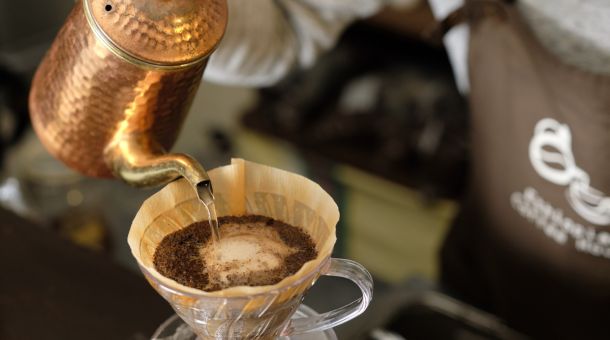How to Make Best Coffee at Home
Coffee is the beverage of choice for millions of people around the world. Whether you’re a coffee connoisseur or simply need a cup to get your day started, brewing the perfect cup of coffee is an art form that can take some practice to master.
Making great coffee at home can seem like a daunting task, but with the right equipment and technique, it’s easier than you might think. Not only is it more affordable in the long run, but it also allows you to experiment with different flavors and brewing methods to find the perfect cup.
This article will cover how to make the best coffee at home. Rather than listing out the steps (which we’ve done elsewhere), we’ll cover some ways to turn your average cup into something amazing.
How to Make Best Coffee at Home

This list isn’t about making a standard coffee with a drip coffee maker. It’s about how to make the best coffee at home using a slightly more adaptable method, whether this is a French press, espresso maker, Moka pot, or another option. So, here are some tips on how to make an amazing cup.
1. Grind Your Beans
If you’re not already grinding your coffee beans, this is your sign to start. Sure, pre-ground coffee is convenient, but it produces less flavorful coffee. You won’t appreciate the difference until you’ve tried both.
Grinding beans start degassing, escaping gas (and, by extension, flavor). After roughly 8 days, your ground coffee will have lost up to 70% of its flavor.
To avoid this, only grind what you need when you need it. It takes a bit more time, but coffee experts say it’s worth it.
2. Get the Right Grind
Coffee typically comes in 3 grind settings: fine, medium, and coarse. It helps to know which you need for your chosen brewing method and why you need to switch it up.
The coarseness of your coffee grind matters because it affects how water saturates the grounds. A fine grind means water moves through slower and can extract the coffee flavor more quickly.
A coarse grind, on the other hand, has less surface area and allows water to move through more quickly. By extension, the coffee needs longer to brew.
Espresso makers and Moka pots need a fine grind, and a French press needs the coarsest grind. For other brewing methods, it’s best to experiment to see what works, but use the logic above as a starting point – shorter brew times require more finely-ground coffee.
3. Wet Your Kit
Everything that your coffee touches should be close to brewing temperature in advance. Generally, this means pre-heating your French press pot or running water through your espresso maker.
It helps because cold brewing equipment will suck heat out of your water. This reduces the temperature, affecting your coffee’s flavor and brew time.
You don’t need to do loads to pre-heat your equipment – it’ll only need a minute or two for a pot or about an espresso worth of water for a machine.
4. Get the Right Temperature
Coffee shouldn’t be made with freshly boiled water. It’s too hot and can burn the coffee, making it taste unpleasant. However, the sweet spot for a perfect cup is just below – between 195 and 204F (90-96C).
This range results in the right blend of acidity, bitterness, and sweetness, although these depend on the coffee itself. If you want your coffee to be as acid-free as possible, switch to cold brewing. Some amount of acidity is best, though.
5. Allow Coffee to Bloom
Coffee blooming isn’t a secret, but it’s not a term many at-home coffee makers know. In short, it’s part of the brewing process when you pour water over the coffee, and it bubbles.
This happens because the water enters the coffee grounds, dissolving soluble compounds and releasing CO2. It’s more obvious with freshly-ground coffee because, as mentioned, it has more carbon dioxide.
Luckily, it’s pretty easy to let your coffee bloom. Cover the grounds with enough water to saturate them, leave them for 30 seconds, and then pour over the rest of the water. You can also pour over all your water first, but using less makes the gas’s escape easier.
6. Choose a Method that Suits Your Drinking Style
This might not be a secret, but knowing how to make the best coffee at home means finding the right brewing method. It should align with your preferred way of drinking coffee.
For example, French press and drip filters make longer, slightly weaker cups. On the other hand, Moka pots and espresso makers produce short, strong coffee. You can always water these or add milk to make a different drink.
It’s not rocket science, but use different methods to see which fits you best. Remember that some take longer to brew than others, and some require more involvement, whereas something like a drip filter can be left alone.
7. Learn About Flavor Profiles
Much attention is paid to coffee flavor profiles, such as wine and other specialty products. While you might be unable to tell these apart, it can help you learn the lingo to choose varieties you like.
Some general terms include:
- Light roast: fruity, tangy, floral, sweet
- Medium roast: chocolatey, balanced, rounded, smooth, mellow
- Dark roast: smoky, caramel, toasted, bitter, full-bodied
These might not mean much to you, but try different coffee types to find one you like. From there, look at what adjectives apply to it and use these to choose new types in the future.
Also, remember that single-origin coffees usually have subtler yet more consistent flavor profiles. Blends are less expensive but can vary more in their taste.
How to Choose the Best Coffee Beans for Home Brewing
There are two main types of coffee beans: Arabica and Robusta. Here are the best types of coffee beans to use for home brewing:
- Arabica beans
- Colombian beans
- Ethiopian beans
- Brazilian beans.
- Sumatran beans
Ultimately, the best type of coffee bean for home brewing is subjective and depends on your taste preferences. Experiment with different types of coffee beans until you find the flavor profile that suits you.
Essential Tools and Equipment for Home Coffee Brewing:
You will need essential tools and equipment to make great coffee at home. Below are a few of the most significant ones:
- Choose a coffee maker that suits your taste, such as a drip coffee maker, French press, or pour-over method. Many different coffee makers are available, each with advantages and disadvantages.
- A coffee grinder is essential for grinding fresh coffee beans. Burr grinders are the best for home coffee brewing, as they offer precise and consistent grinding.
- Measuring your coffee and water by weight rather than volume can help ensure consistency and accuracy. A kitchen scale with a tare function measures coffee and water.
- A gooseneck kettle with a built-in thermometer is ideal for brewing methods that require precise temperature control, such as pour-over coffee.
- You will need coffee filters using a drip coffee maker or pour-over method. Choose filters compatible with your coffee maker and made of high-quality materials.
- Choose a coffee mug that is the right size and shape. Look for mugs made of high-quality materials, such as ceramic or glass.
- Keeping your coffee maker and grinder clean is essential for maintaining the quality and flavor of your coffee. Invest in cleaning tools such as a brush, cloth, and cleaning solution.
What Are Some Common Mistakes to Avoid When Brewing Coffee at Home?
Here are some common mistakes to avoid when brewing coffee at home :
- Using stale coffee beans
- Not measuring the coffee and water
- Using the wrong grind size
- Not cleaning your coffee maker
- Using water that is too hot or too cold
- Over-extracting or under-extracting the coffee
- Not experimenting with different brewing methods.
What Is the Best Water Temperature for Brewing Coffee at Home?
The best water temperature for brewing coffee at home is between 195°F and 205°F (90°C and 96°C). Water that is too hot can over-extract the coffee, leading to a bitter taste, while water that is too cold can under-extract the coffee, resulting in a bland and sour taste.
If you’re using a pour-over method or a French press, it’s important to let the water cool slightly after boiling before brewing coffee. This will help ensure that the water temperature is within the optimal range.
If you do not possess a thermometer, there are alternative ways to boil the water and let it sit for a minute or two before using it for brewing. This should help bring the temperature within the optimal range.
How Long Should I Brew Coffee for Optimal Flavor and Strength?
The optimal brewing time for coffee depends on the brewing method and the type of coffee being used. Here are some general guidelines for brewing times:
- Drip coffee: The optimal brewing time for drip coffee is 4-6 minutes. This method uses gravity to brew the coffee, which drips the water through the coffee grounds and filter.
- French press: The optimal brewing time for French press coffee is 4 minutes. The process entails immersing the coffee grounds in hot water and pressing the plunger to separate the coffee from the grounds.
- Pour-over: The optimal brewing time for pour-over coffee is 2-3 minutes. This method involves pouring hot water over the coffee grounds and letting the coffee drip through the filter.
- Espresso: The optimal brewing time for espresso is 20-30 seconds. This method uses high pressure to extract the coffee flavor from finely ground coffee beans.
How Should I Store My Coffee Beans to Ensure Freshness and Flavor?
Storing your coffee beans properly is essential to retain their freshness and flavor. Here are some tips on how to store your coffee beans:
- Keep your beans in an airtight container: Oxygen is one of the main enemies of fresh coffee, so storing your beans in an airtight container is important to minimize exposure to air.
- Store in a cool, dry place: Coffee beans can be sensitive to moisture and heat, so it’s best to store them in a cool, dry place away from direct sunlight.
- Don’t store in the fridge or freezer: Contrary to popular belief, storing coffee beans in the fridge or freezer can cause moisture to build up on the beans, affecting the flavor. It’s best to store them at room temperature.
- Buy in small quantities: To ensure that your coffee beans are always fresh, it’s best to buy them in small quantities and use them within a few weeks. This will help ensure that the beans are at their peak flavor and aroma.
Final Thoughts
brewing the best coffee at home requires knowledge and attention to detail, but enjoying a delicious and satisfying cup of coffee is worth the effort. You can always achieve a great cup of coffee by selecting high-quality beans, using the right equipment, and avoiding common mistakes.
Remember to experiment with different brewing methods and adjust variables such as water temperature and brewing time to find the flavor that suits your taste. By dedicating time and effort, you can develop the skill to become a skilled home barista and enjoy a delicious cup of coffee from the comfort of your own home.
How to Make Best Coffee at Home How to Make Best Coffee at Home How to Make Best Coffee at Home How to Make Best Coffee at Home How to Make Best Coffee at Home How to Make Best Coffee at Home How to Make Best Coffee at Home How to Make Best Coffee at Home How to Make Best Coffee at Home How to Make Best Coffee at Home

